Development of two-component reflection models for high-emissive coatings on the base of incomplete data sets.
Two-component (diffuse and quasi-specular) models were developed on the base of incomplete initial data sets (spectral directional-hemispherical reflectances and quasi-specular components measured for several incidence angles). Developed models were applied to the Monte Carlo calculation of spectral effective emissivities and radiance temperature for low-temperature IR on-board blackbody calibration sources.
Two-component (diffuse and quasi-specular) models were developed on the base of incomplete initial data sets (spectral directional-hemispherical reflectances and quasi-specular components measured for several incidence angles). Developed models were applied to the Monte Carlo calculation of spectral effective emissivities and radiance temperature for low-temperature IR on-board blackbody calibration sources.



Development of the Monte Carlo ray-tracing algorithm and software for rectangular array of truncated pyramids.
Developed software was applied to calculation of radiation characteristics of the pyramid cluster calibration target for remote sensing applications.
Developed software was applied to calculation of radiation characteristics of the pyramid cluster calibration target for remote sensing applications.
Parametric study, tuning, and performance comparison of three Particle Swarm Optimisation algorithms for global minimum search of multimodal functions.
Three algorithms of Particle Swarm Optimization were applied for global optimization problem in up to 10-dimensional search space and their performances were compared. Common set of benchmark functions was used for performance assessment. Optimal ranges of tuning parameters were determined.
Animation on the right visualizes the optimisation process for a standard 2D benchmark function.
Later, one of these algorithms was used for fitting parameters of the 3C BRDF model to experimental BRDF data.
Three algorithms of Particle Swarm Optimization were applied for global optimization problem in up to 10-dimensional search space and their performances were compared. Common set of benchmark functions was used for performance assessment. Optimal ranges of tuning parameters were determined.
Animation on the right visualizes the optimisation process for a standard 2D benchmark function.
Later, one of these algorithms was used for fitting parameters of the 3C BRDF model to experimental BRDF data.


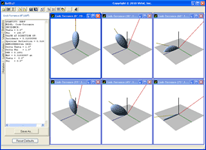

BRDF Explorer - software for studying analytical and procedural reflection models, visualization of BRDF in 2D and 3D graphs, calculation of biconical, directional-hemispherical, and bihemispherical reflectances, and for combining various reflection models.
STEEP3 v. 5.1 and v. 5.2 - blackbody emissivity modeling programs that use the angle-dependent specular-diffuse model of reflection.
INTETHER - software for correction of directional-hemispherical reflectance values using measured optical throughput non-uniformity of the integration sphere of IR spectral range.
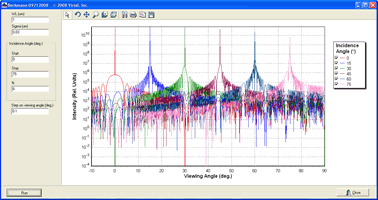

Feasibility study of combining Beckmann's scattering theory and Monte Carlo ray tracing to computer modeling of reflection from random rough surfaces.
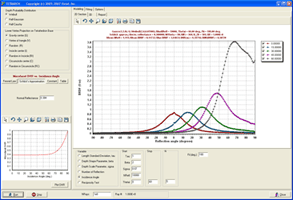



Tetrarch - test software for parametric study of the TETRA BRDF procedural model of reflection from random rough surfaces.
Development of data processing software for cryogenic blackbody calibration in the Far IR spectral range.


LET - software for calculation of uncertainties propagation and uncertainty budget assessment for spectral radiance of thermal radiation sources.
Tube - Monte Carlo ray tracing software for calculation of absoption in the hollow cylindrical light guide.
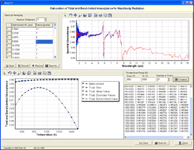
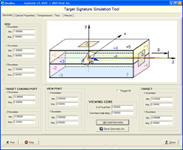
AbsopT2 - program calculating band-limited and total absorptance of black coating as a function of temperature.
BlackBox - software for Monte Carlo modeling of reflection indicatrix for aerial targets.
TDrop - program for calculation of steady-state temperature distributions along the generatrix of cylindrical cavity. Software considers heat conduction, convection, and radiative heat transfer. View factors between elements of the cavity internal surface and the aperture were computed by the Monte Carlo method taking into account multiple reflections.
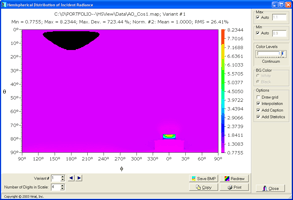












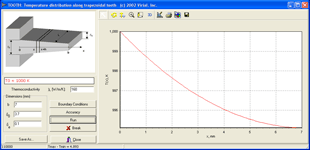




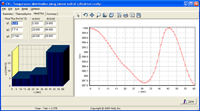
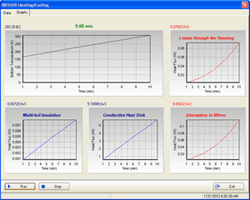
Software for computer modeling of transient temperatures in the large-area blackbody radiator with reflecting concentrator.
The blackbody is heating up to the operational temperature of about 1000 K. Average radiator temperature and heat losses through structiral components are shown in the animation as a function of heating time.
The blackbody is heating up to the operational temperature of about 1000 K. Average radiator temperature and heat losses through structiral components are shown in the animation as a function of heating time.
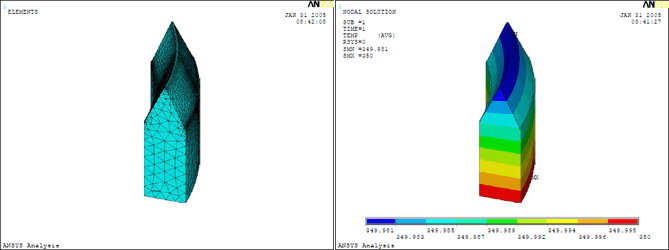
Presision Large-Area Low-Temperature Blackbody BB100V1 for IR Calibrations. Conceptual Design and Computer Modeling.
A finite element model was built for the low-temperature cylindrical blackbody with V-grooved bottom. Steady-state temperature distributions were computed using ANSYS® FEM software. Computed temperature distributions were used for calculation of effective emissivities using STEEP3 program. Pictures above show the finite element model for the fragment of cavity bottom and 3D temperature distribution. Read report.
A finite element model was built for the low-temperature cylindrical blackbody with V-grooved bottom. Steady-state temperature distributions were computed using ANSYS® FEM software. Computed temperature distributions were used for calculation of effective emissivities using STEEP3 program. Pictures above show the finite element model for the fragment of cavity bottom and 3D temperature distribution. Read report.


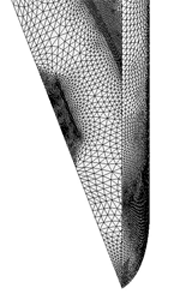
Thermal modeling of the absolute cryogenic radiometer.
Steady-state temperature distributions were computed for an absolute cryogenic radiometer with electrical substitution. The shell finite element model was created for ANSYS® FEM software.
Two types of electrical heating elements were investigated to evaluate and minimize the substitution non-equivalence of laser radiation optical power by electical power of heater.
Steady-state temperature distributions were computed for an absolute cryogenic radiometer with electrical substitution. The shell finite element model was created for ANSYS® FEM software.
Two types of electrical heating elements were investigated to evaluate and minimize the substitution non-equivalence of laser radiation optical power by electical power of heater.
Monte Carlo modelling of the radiance non-uniformity of the calibration unit integrating sphere.
The BRDF model for sinthered PTFE was developed and used in the Monte Carlo modelling of the radiance non-uniformity at the exit ports of the K-band Multi-Object Spectrograph (KMOS) calibration unit integrating sphere of the ESO Very Large Telescope (VLT).
Read report
The BRDF model for sinthered PTFE was developed and used in the Monte Carlo modelling of the radiance non-uniformity at the exit ports of the K-band Multi-Object Spectrograph (KMOS) calibration unit integrating sphere of the ESO Very Large Telescope (VLT).
Read report
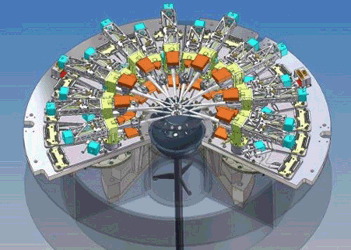

Monte Carlo modeling of the integrating sphere uniform radiation source. The picture for relative distribution of radiance across the exit port of the integrating sphere is adopted from: A.V. Prokhorov and L. M. Hanssen, "Numerical Modeling of an Integrating Sphere Radiation Source," Proc. SPIE 4775, 106-118 (2002)).



Software for 3D and 2D visualisation of the hemispherical relative distribution of the radiance incident onto the sample center in the integrating sphere reflectometer for Vis and NIR spectral range (the right-hand picture is adopted from: A. V. Prokhorov, S. N. Mekhontsev, and L. M. Hanssen, "Monte Carlo Modeling of an Integrating Sphere Reflectometer," Appl. Opt. 42, 3832-3842 (2003)).
Ray tracing software for cylindrical mapping of the integrating sphere IR reflectometer and for optimization of mutual positions and orientations of internal baffles (picture is adopted from: L. M. Hanssen, A. V. Prokhorov and V. Khromchenko, "Specular baffle for improved infrared integrating sphere performance," Proc. SPIE 5192, 101-110 (2003)).

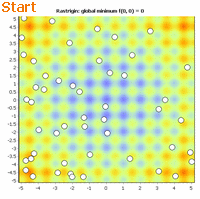





Modification of the Torance-Sparrow model of reflection from random rough surfaces for Monte Carlo ray tracing applications.


Jawws - software for Monte Carlo modeling of the device for IR reflectance measurement by the heated cavity method. The cavity is shaped as a sphere with radial V-grooves suppressing specular component of reflection. Temperature drop along radial teeth was taking into account.
Program complex for analytical and Monte Carlo calculations of diffuse view factors in the system of surfaces for geometrical configurations used in radiometric applications.
Program for minimization of temperature non-uniformity for the medium temperature blackbody with three independent heating elements.

Shuttle II - programs for evaluation of uncertainty introduced in the effective emissivity calculations by using BRDF models that violate the reciprocity principle.
Tooth - program calculating the temperature distribution along trapezoidal fin for the coupled conductive, convective, and radiative heat exchange.













